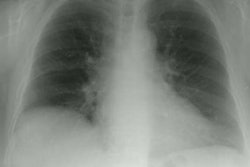Chest 1995 Aug;108(2):316-319
Pulmonary findings in patients with primary Sjogren's syndrome.
Lahdensuo A, Korpela M
STUDY OBJECTIVE: To evaluate pulmonary findings in patients with primary Sjogren's syndrome (SS). DESIGN: Prospective data collection. PATIENTS: Seventeen consecutive nonsmoking patients with primary SS. MEASUREMENTS AND RESULTS: Mild radiologic parenchymal changes were seen in two patients. Pulmonary hyperinflation (residual volume/total lung capacity [RV/TLC] percent ratio measured minus [-] RV/TLC percent ratio predicted > or = 8) was observed in 9 (53%) patients, whereas obstructive and restrictive changes were infrequently found in ordinary spirometry (FVC, FEV1, FEV%) (none and two cases, respectively). Patients with SS with hyperinflation had significantly lower maximal expiratory flow MEF50 (p < 0.05), MEF25 (p < 0.05), and higher total lung capacity (p < 0.05) and FRC (p < 0.05) values as compared with those patients with SS without hyperinflation. They were also more frequently dyspnoeic (six vs none, p < 0.02) and had higher mean serum beta 2-microglobulin levels (3.6 +/- 1.0 mg/L vs 2.6 +/- 0.7 mg/L, p < 0.025). The levels of serum beta 2-microglobulin correlated inversely with FVC (r = - 0.583, p < 0.01), FEV1 (r = - 0.533, p < 0.05), diffusing capacity for carbon monoxide (r = - 0.580, p < 0.01); its correlation with RV/TLC percent ratio was positive and relatively significant (r = 0.447, 0.05 < p < 0.10). CONCLUSIONS: Pulmonary hyperinflation associated with diminished peripheral spirometric flow values is frequently found in patients with primary SS. This together with the correlation of disturbed lung function parameters to elevated serum beta 2-microglobulin levels suggests that lungs and especially small airways may be an usual target organ in primary SS.
